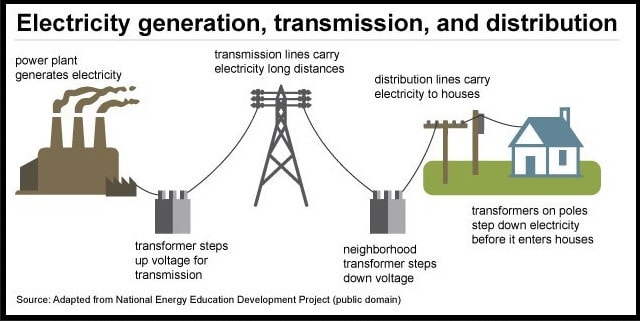
Welcome to the fascinating world of smart grids! So, how does a smart grid work? Let’s dive in and discover the exciting technology behind it.
Imagine a super-smart, high-tech power system that does much more than deliver electricity to your home. A smart grid is like having a superpower for your electricity because it can do incredible things to make the whole electrical system more efficient and reliable.
With a smart grid, power companies can monitor energy usage in real time, making sure electricity is distributed precisely where it’s needed. It’s like having a brain that helps manage the flow of electricity, ensuring that everyone receives the power they require.
So, buckle up and join me on this electrifying journey to uncover the secrets of how smart grids work and why they are powering the future! Get ready to meet the intelligence behind your electrical supply.
Discover the inner workings of the smart grid and how it revolutionizes our energy system. The smart grid utilizes advanced technologies like sensors, meters, and communication networks to enable two-way flow of electricity and provide real-time data.
With this innovative system, power outages can be detected and restored faster, energy demand can be managed efficiently, and renewable energy sources can be integrated seamlessly. Learn more about the fascinating world of the smart grid and its impact on energy sustainability.

How Does Smart Grid Work?
Smart grid technology has transformed the way we produce, distribute, and consume electricity. This innovative system uses digital communication and advanced sensors to optimize energy management, improve reliability, and reduce environmental impact. In this article, we will delve into the intricacies of how a smart grid works, exploring its key components, benefits, and challenges.
The Basics of Smart Grid
At its core, a smart grid is an intelligent electricity network that enables two-way communication between the utility provider and the consumer. It encompasses various technologies, including smart meters, distribution automation, and advanced control systems.
Unlike traditional power grids, which operate with limited visibility and control, smart grids leverage real-time data to enhance efficiency and responsiveness.
One of the primary components of a smart grid is the deployment of smart meters. These devices are installed in homes and businesses to measure electricity consumption and communicate the data back to the utility company.
By providing real-time usage information, smart meters enable consumers to make informed decisions about their energy consumption, helping them reduce costs and lower their carbon footprint.
Another essential feature of smart grids is distribution automation. This technology integrates sensors and advanced monitoring systems throughout the electricity distribution network.
It allows utilities to identify and address issues such as power outages or equipment malfunctions more rapidly. With remote control capabilities, operators can isolate affected areas and restore power faster, minimizing disruptions for consumers.
The Role of Renewable Energy Integration
With the increasing focus on sustainability, smart grids play a crucial role in integrating renewable energy sources into the electricity distribution system. While traditional power grids face challenges in managing the intermittent nature of renewable energy, smart grids offer sophisticated solutions to optimize the utilization of these resources.
Renewable energy integration in smart grids is achieved through advanced control systems and forecasting algorithms. These technologies enable the grid to predict and adjust electricity generation and consumption based on the availability of renewable resources.
By dynamically balancing supply and demand, smart grids help maximize the utilization of clean energy sources while ensuring the stability and reliability of the electricity network.
Furthermore, smart grids facilitate the integration of distributed energy resources (DERs), such as rooftop solar panels or small wind turbines.
Through bidirectional communication, smart grids enable DERs to feed excess electricity into the grid, reducing dependence on centralized power generation. This decentralized approach not only promotes clean energy adoption but also enhances the resilience and flexibility of the electricity system.
Benefits of Smart Grid
The implementation of smart grid technology brings about a plethora of benefits to all stakeholders involved. Let’s explore some of the key advantages:
- Improved Reliability: Smart grids enable faster detection and response to power outages, minimizing the duration and impact of interruptions.
- Energy Efficiency: By providing real-time data on energy consumption, smart meters empower consumers to make informed choices and optimize their usage, resulting in energy savings.
- Enhanced Grid Security: Smart grids incorporate robust cybersecurity measures to protect the network from cyber threats, ensuring the integrity and privacy of data.
- Increased Sustainability: By integrating renewable energy sources and promoting energy conservation, smart grids contribute to greenhouse gas emissions reduction and a more sustainable energy future.
- Operational Cost Savings: Smart grids enable utilities to optimize their operations, reduce maintenance costs, and allocate resources more efficiently.
These benefits highlight the transformative impact of smart grid technology, revolutionizing the way we manage and consume electricity.
Challenges and Future Outlook
While smart grids offer tremendous potential, they also face several challenges in their widespread deployment. One of the main obstacles is the significant investment required to upgrade existing infrastructure and install smart grid components.
Additionally, ensuring interoperability and data management across various systems and devices poses technical complexities.
However, governments, utilities, and industry stakeholders recognize the importance of smart grids in building a sustainable and resilient energy ecosystem.
Efforts are underway to create favorable policies, incentivize investments, and develop standardized protocols for seamless integration.
The future of smart grids holds immense promise. As technology continues to advance, we can expect more innovative solutions such as grid-scale energy storage, advanced demand response systems, and smart appliances that interact with the grid.
These advancements will further enhance the efficiency, reliability, and sustainability of our electricity networks.
The Evolution of Smart Grid Technology
Smart grid technology has undergone significant advancements since its inception. As the needs and demands of the energy sector continue to evolve, the development of smart grid solutions has kept pace.
In this section, we will explore the evolution of smart grid technology and the key milestones that have shaped its journey.
Early Developments and Pilot Projects
The concept of smart grids emerged in the early 2000s as a response to growing concerns about the environmental impact of traditional power grids and the need for greater energy efficiency.
In the initial stages, various pilot projects were launched to evaluate the feasibility and benefits of implementing smart grid technologies.
One of the earliest smart grid initiatives was the Pacific Gas and Electric (PG&E) SmartMeter program in California, launched in 2006.
This project involved the installation of smart meters in residential and commercial properties, enabling real-time data collection and remote management of electricity consumption. The success of this program paved the way for further smart grid deployments.
As pilot projects demonstrated the potential of smart grid technologies, governments and industry stakeholders began investing in research and development initiatives to accelerate their adoption.
These efforts led to significant advancements in communication protocols, sensor technologies, and data analytics, setting the stage for the widespread deployment of smart grids.
Standardization and Interoperability
To foster the growth of smart grid technology and ensure seamless integration of various components and devices, standardization became a key focus.
Standardization bodies such as the International Electrotechnical Commission (IEC) and the Institute of Electrical and Electronics Engineers (IEEE) played a vital role in developing international standards for smart grid communication, cybersecurity, and interoperability.
The development of these standards, such as IEC 61850 for communication in substations and IEEE 2030.5 for smart grid interoperability, enabled the industry to overcome technical barriers and facilitate the exchange of information between diverse systems.
This interoperability has been critical in enabling the integration of renewable energy sources, electric vehicles, and other emerging technologies into the grid.
Furthermore, partnerships and collaborations between utilities, technology providers, and regulatory authorities have fostered innovation in smart grid technology.
These collaborations have facilitated the sharing of best practices, pilot projects, and research findings, driving the development of robust and scalable solutions.
Advanced Grid Management and Future Innovations
As smart grid technology continues to evolve, grid management capabilities have become increasingly sophisticated. Advanced control systems, predictive analytics, and artificial intelligence (AI) algorithms are revolutionizing the way utilities manage and optimize their electricity networks.
Grid-scale energy storage solutions, such as large-scale batteries and pumped hydro storage, are emerging as key components of smart grids. These storage systems enable the integration of intermittent renewable energy sources, providing flexibility and stability to the grid.
Looking ahead, the integration of electric vehicles (EVs) into smart grids holds immense potential. EVs not only serve as a cleaner mode of transportation but also have the capability to store and supply electricity back to the grid, acting as energy storage devices.
This bidirectional flow of electricity between EVs and the grid can help balance electricity supply and demand, enhancing grid stability and supporting renewable energy integration.
Smart Grid Standards and Cybersecurity
As the deployment of smart grids continues to expand, ensuring cybersecurity becomes increasingly crucial.
Smart grids, with their interconnected devices and communication networks, are exposed to cybersecurity threats that can have severe consequences on the reliability and integrity of the electricity system.
In this section, we will explore the importance of smart grid standards in ensuring cybersecurity and the measures taken to protect this critical infrastructure.
The Need for Cybersecurity Standards
Smart grids rely on a complex network of devices, sensors, and communication protocols to collect and transmit data.
This interconnectedness creates vulnerabilities that can be exploited by malicious actors to disrupt or manipulate the operation of the grid. To safeguard the smart grid infrastructure, it is essential to establish robust cybersecurity standards.
Cybersecurity standards provide guidelines and best practices for securing the various components of a smart grid, ranging from smart meters and communication networks to control systems and data storage.
These standards address potential threats such as unauthorized access, data breaches, and denial-of-service attacks, ensuring critical systems’ confidentiality, integrity, and availability.
By adhering to established cybersecurity standards, utilities and technology providers can mitigate risks, build resilient systems, and maintain trust in the smart grid infrastructure.
Key Smart Grid Cybersecurity Standards
Several organizations and standardization bodies have developed cybersecurity standards specifically tailored for smart grids. These standards provide comprehensive frameworks for securing the entire ecosystem, from edge devices to centralized control centers.
Here are some key standards:
- IEC 62351: This international standard focuses on the security of power system control operations and includes guidelines for key management, access control, and data integrity.
- NISTIR 7628: Developed by the National Institute of Standards and Technology (NIST), this document provides guidelines and best practices for securing smart grid systems through the application of risk management principles.
- ISO/IEC 27001: This widely recognized information security management standard serves as a foundation for developing a systematic approach to managing security risks in smart grid environments.
In addition to these standards, governments and regulatory authorities often enforce their own cybersecurity guidelines to ensure the protection of critical infrastructure.
It is vital for utilities and technology providers to stay up to date with these standards and regulations to maintain compliance and mitigate potential cybersecurity risks.
Measures and Technologies for Smart Grid Cybersecurity
In addition to adhering to cybersecurity standards, multiple measures and technologies are employed to enhance the security of smart grids:
- Encryption: Encryption techniques are used to protect sensitive information transmitted over communication networks, ensuring that data remains confidential and secure.
- Authentication: Strong authentication mechanisms, such as two-factor authentication, are implemented to verify the identity of users and devices accessing the smart grid infrastructure.
- Intrusion Detection Systems (IDS): IDS monitors network traffic to identify and respond to potential security breaches, enabling rapid incident response and mitigation.
- Security Event Management: Centralized security event management systems collect and analyze data from various security devices, helping to identify and respond to security incidents effectively.
Furthermore, continuous monitoring, vulnerability assessments, and regular security audits are essential to identify and address emerging threats in the ever-evolving field of cybersecurity.
The Future of Smart Grids: Innovations and Trends
The evolution of smart grid technology continues at a rapid pace, driven by the need for sustainability, grid reliability, and increased energy efficiency.
In this section, we will explore some of the emerging innovations and trends that are shaping the future of smart grids.
Grid-scale Energy Storage
Grid-scale energy storage solutions are crucial for managing the intermittency of renewable energy sources and maintaining grid stability.
Innovations in battery technology, such as advanced lithium-ion batteries and flow batteries, have significantly increased the efficiency and capacity of energy storage systems.
In addition to batteries, other energy storage technologies like pumped hydro storage, compressed air energy storage, and hydrogen-based systems are gaining prominence.
These storage solutions provide the flexibility required to balance the supply and demand of electricity in a smart grid, ensuring reliable and sustainable power delivery.
Internet of Things (IoT) Integration
The integration of IoT devices in smart grids is revolutionizing the way energy systems are managed and optimized. IoT devices, such as smart thermostats, connected appliances, and EV charging stations, provide real-time data on energy consumption and enable demand response programs.
By leveraging the vast amount of data collected from IoT devices, utilities can make informed decisions on load balancing, grid optimization, and energy conservation. This integration enhances the overall efficiency of the smart grid, reduces costs, and promotes sustainability.
Artificial Intelligence and Machine Learning
The use of artificial intelligence (AI) and machine learning algorithms is transforming the way smart grids operate. These technologies enable predictive analytics, fault detection, and optimization of energy management systems.
AI-based algorithms can analyze complex data patterns, identify potential faults or failures, and provide proactive solutions to mitigate risks. Machine learning models can also optimize energy dispatch and distribution, taking into account factors such as weather conditions, energy demand, and pricing.
Microgrids and Peer-to-Peer Energy Trading
Microgrids are localized electricity distribution systems that can operate independently or in conjunction with the main power grid. These self-sufficient grids incorporate renewable energy sources, energy storage, and advanced control systems.
One of the emerging trends in smart grids is peer-to-peer energy trading within microgrids. Blockchain technology facilitates secure and transparent transactions between producers and consumers, allowing for direct peer-to-peer energy transfers. This decentralized approach empowers individuals and communities to participate actively in the energy market and promotes renewable energy adoption.
Key Takeaways: How Does Smart Grid Work?
- A smart grid is an advanced electrical grid that uses digital technology to optimize energy distribution.
- It enables two-way communication between the utility company and consumers, allowing for efficient energy management.
- Smart meters are installed in homes and businesses to track energy usage and provide real-time data.
- Renewable energy sources like solar and wind can be integrated into the smart grid, reducing reliance on fossil fuels.
- Smart grids help prevent power outages by quickly identifying and isolating issues, improving overall reliability.
Frequently Asked Questions
Interested in learning about how the smart grid works? Look no further! We’ve got you covered with some commonly asked questions and their answers. Read on to discover the ins and outs of smart grid technology.
1. How does a smart grid save energy?
A smart grid optimizes energy consumption by incorporating digital technology into the power distribution system. Unlike traditional grids, a smart grid uses advanced sensors, meters, and communication networks to gather real-time data about electricity usage.
This valuable information allows utility companies to monitor and manage energy flow more efficiently, resulting in reduced wastage and optimized power distribution. By enabling consumers to make smarter energy choices and eliminating manual meter readings, a smart grid can contribute to significant energy savings.
Additionally, through its two-way communication capabilities, a smart grid enables the integration of renewable energy sources like solar and wind power by efficiently balancing the supply and demand of electricity. This reduces reliance on fossil fuels and helps promote a greener and more sustainable energy future.
2. What are the benefits of a smart grid?
A smart grid offers several benefits to both utility companies and consumers. By improving the monitoring and control of electricity distribution, a smart grid enhances the reliability and efficiency of the entire power system. This leads to fewer power outages and faster restoration of service in case of any disruptions, resulting in improved overall electricity reliability.
For consumers, a smart grid provides real-time information about their energy usage, allowing them to decide when and how to use electricity. This empowers them to optimize their energy consumption, potentially leading to lower electricity bills.
Additionally, a smart grid enables the integration of renewable energy sources, facilitating a transition to a cleaner and more sustainable energy future.
3. How does a smart meter work in a smart grid system?
A smart meter is a key component of a smart grid system. It measures and records electricity usage at regular intervals throughout the day, providing detailed consumption data. Unlike traditional meters, smart meters can communicate this information in real time to both consumers and utility companies via a secure network.
This enables consumers to monitor their energy usage patterns and make informed decisions about their electricity consumption.
Smart meters also benefit utility companies by eliminating the need for manual meter readings and enabling remote disconnect and reconnect services.
They allow for quicker detection and resolution of power outages, as utility companies can remotely identify the affected areas and dispatch repair crews efficiently.
4. How does a smart grid improve grid resilience?
A smart grid improves grid resilience by enhancing its ability to handle disruptions, both natural and man-made.
Through intelligent automation and monitoring, a smart grid can detect and isolate any faults or outages more quickly and accurately. This enables prompt restoration of service to unaffected areas while minimizing the impact on customers.
Furthermore, a smart grid’s ability to integrate renewable energy sources and distributed energy resources enhances the grid’s resilience. By diversifying the sources of electricity generation, the system becomes less vulnerable to disruptions in one particular area.
In the event of a natural disaster or a cyber-attack, the smart grid can dynamically reroute power and adapt to changing conditions, mitigating the impact on customers and ensuring a more resilient power supply.
5. How does a smart grid impact cybersecurity?
A smart grid introduces new digital technology and communication networks, which increases the complexity of the system and its vulnerability to cyber threats. However, stringent cybersecurity measures are implemented to protect the grid from potential attacks.
Firstly, encryption and authentication techniques are used to secure communication between different components of the smart grid system.
This ensures that only authorized devices and systems can access and exchange data. Additionally, continuous monitoring and anomaly detection systems are deployed to identify any suspicious activities or breaches in the network. Regular security updates and patches are also applied to mitigate potential vulnerabilities.
Moreover, collaboration between industry stakeholders, government agencies, and cybersecurity experts is crucial in managing and minimizing cyber risks. Robust cybersecurity practices and protocols are established to protect the smart grid infrastructure and ensure the reliable delivery of electricity.
So, to sum it up, a smart grid is a modern electricity system that uses advanced technology to make our power supply more efficient, reliable, and sustainable.
It uses sensors, meters, and computer systems to collect and analyze data, which helps in managing energy demand, identifying outages, and integrating renewable energy sources. By doing so, not only reduces our carbon footprint but also saves us money in the long run.
In a smart grid, electricity flows two ways: from power plants to our homes, and from our homes back to the grid. This allows us to generate our own power through solar panels or wind turbines and sell any excess electricity back to the grid.
The smart grid also enables us to monitor our energy usage in real time, giving us greater control over our electricity consumption. By optimizing the way we produce, distribute, and consume electricity, the smart grid is paving the way toward a greener and more sustainable future for all of us.






